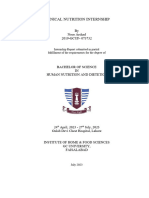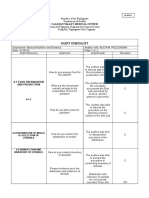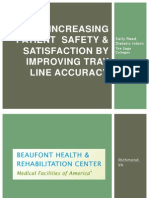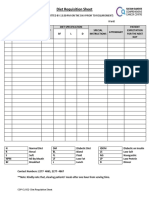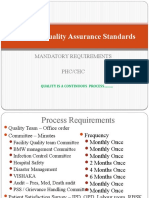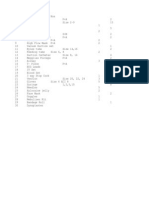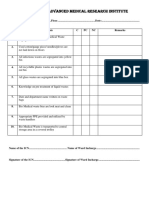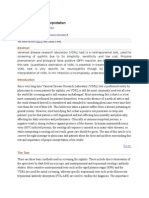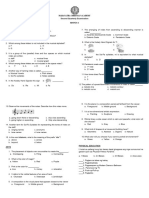Diet Nabh Guidelines
Uploaded by
Aruna HarikrishnanDiet Nabh Guidelines
Uploaded by
Aruna HarikrishnanThe Food services department of hospital is responsible for fulfilling the food and diet
requirements patients. In addition to patient, it can also cater to employees, patients’ family
members and visitors. The food services for patients plays important role in aiding to treatment
and faster recovery of patient. The quality objectives of food services in hospital should be to
provide right food to right patient at right time, provide food that is safe to
consume and palatable and to avoid wastages of food. To meet these objectives there are
certain practices that must be followed which are also given under NABH standards. Here is the
list of what a hospital’s food services department must do to provide quality services and also to
meet NABH accreditation norms. Note that these standards are applicable even if the kitchen is
outsourced
A. Infrastructure
1. The kitchen of the hospital should have an identified area and its ___location should be
segregated from patient areas and traffic flows.
2. The space should be sufficient to effectively carry out all functions of kitchen. The sub-
areas within kitchen should comprise of following,
1. Raw material receiving and storage area (includes cold storage)
2. Preparation area – for preparing raw materials (peeling, cutting, slicing etc.)
before cooking
3. Cooking area – where the actual cooking takes place
4. Special diet area – here special diets such as soft diet, diabetic diet etc. are
prepared
5. Servicing area – here the plates are prepared with food and laid on
6. Washing area – for pots, cutleries and trolleys
7. Garbage collection area
8. Administrative areas
3. The kitchen should have access to firefighting measures, either fire extinguishers or fire
hose points.
4. An emergency exit should be available for immediate evacuation
5. The walls and ceilings should not have problem of seepages or fungus
6. Engineering measures like electricity supply, water supply (including hot water supply)
and good drainage must be ensured
7. Entry in inside kitchen should be restricted
8. Things like nets on windows, fly catchers, no holes etc. should be installed to prevent
entry of insects and rodents inside kitchen
B. Policies and Processes
1. Diet of the patients’ food must be planned and prepared under the supervision of a
qualified dietician
2. Each patient admitted should be screened by a dietitian for nutritional need on first
day of admission. If required a detailed nutritional assessment should be done
3. Based on screening/assessment dietitian must plan the food to be given to patient. This
should be done by taking treating doctor’s advice and by taking patient/family’s food
preferences in consideration
4. The diet to be given to patient should be written down in a diet sheet. Patient should be
given food according to diet sheet
5. If family is providing the food, they should be counselled about the type of diet to be
given. A written order of food should be given in such cases.
C. Food serving
1. Each food plate or food packet must be labelled, at the time of preparation. The label
must mention type of food (i.e. normal food, soft diet, diabetic, salt free etc.) and patient’s name
and ID number to whom it has to be served
2. Food should be served after properly identifying patient through his/her name and
unique identification number
3. For patients on special diet, a display should be put near patients’ bed to indicate
4. Timing of serving of each meal must be defined and food should be served within that
time.
5. Serving of food should be done to provide convenience. This can be taken care of by
ensuring that plates and containers in which food is being served is appropriate and the food
being served are at a palatable temperature
6. As a practice each meal should be tasted by a designated authority in hospital, and
permitted, before it is served
7. The clearance of plates and left over food should be done within a time-frame
D. Safety, hygiene and maintenance
1. Health check-ups of food handling staff –
1. Any staff who handle food (cooking, serving, cleaning etc.) must be medically
screened to check for presence of any contagious disease.
2. Screening of parasites and Salmonella Typhi should be done every 6 month
and whenever a staff re-joins after taking 15 days or more leave. For other tests annual check
ups can be done.
3. Record of health check-up with findings should be maintained for each staff.
4. Staff in which any contagious or infectious disease is found should not be
allowed to handle food, till the time the infection subsides
2. All areas within the kitchen should be clean at all the time.
3. The food handlers should be clean, wear clean uniform, gloves, caps and masks (as
required). A personal hygiene checklist must be given to each food handlers and should be
monitored periodically
4. Plates, utensils and trolleys which are used for serving should be cleaned regularly
and should be free from dirt or stink
5. Cold storage refrigerators should receive preventive checks to ensure that that
temperature is maintained
6. Raw materials and prepared food should not be stored on floor
7. The housekeeping materials like, broom, mops, cleaning agents etc. must be stored in
separate ___location away from food
8. Regular pest control measures should be undertaken.
9. Kitchen waste should be disposed off regularly
E. Staff awareness: Each staff working in food department must be aware about
following,
1. Personal hygiene to be maintained
2. Hand hygiene practices
3. Hygiene practices to be maintained in Kitchen and while delivering food
4. Practices to prevent error in serving
5. Occupational health hazards of working in
6. Health check-ups required and policy on
7. Safe handling of LPG
8. Other general topics like, employee rights, use of fire extinguisher, emergency codes
etc.
F. Quality Indicators
1. % of time food was not delivered within the time-frame
2. % of food wastage (raw material and cooked food)
3. Diet distribution error per 1000 patient days
4. Patient satisfaction rating to quality of food
You might also like
- Nutritional Assessment Profile Form For Pregnant Mothers56% (9)Nutritional Assessment Profile Form For Pregnant Mothers4 pages
- Dietetic Internship - Mini Case Study PowerpointNo ratings yetDietetic Internship - Mini Case Study Powerpoint21 pages
- Nutrional Assessment Form (Outdoor Patient) Rubab Ijaz100% (4)Nutrional Assessment Form (Outdoor Patient) Rubab Ijaz3 pages
- G-0546 Outpatient Nutrition Assessment Form100% (3)G-0546 Outpatient Nutrition Assessment Form3 pages
- Hospital's Food Services (Kitchen) For Ordnance Factory Dehu Road100% (2)Hospital's Food Services (Kitchen) For Ordnance Factory Dehu Road3 pages
- Antropology and The Problems of Modern Civilization100% (2)Antropology and The Problems of Modern Civilization142 pages
- Organisation of Dietary Services in Hospitals80% (5)Organisation of Dietary Services in Hospitals13 pages
- National Quality Assurance Standards: Mandatory Requirements PHC/CHCNo ratings yetNational Quality Assurance Standards: Mandatory Requirements PHC/CHC14 pages
- Quality Improvement Secretarial: WWW - Qis.gov - BDNo ratings yetQuality Improvement Secretarial: WWW - Qis.gov - BD2 pages
- Therapeutic Diet To Control Different Types of DiseasesNo ratings yetTherapeutic Diet To Control Different Types of Diseases79 pages
- Traning On Education On Safe Parenting Nutrition and Immunisation67% (3)Traning On Education On Safe Parenting Nutrition and Immunisation2 pages
- Aravind Eye Hospital Madurai: Apex Manual-2016100% (4)Aravind Eye Hospital Madurai: Apex Manual-201660 pages
- Checklist For CSSD For NABH Preparation and Its Quality Indicators100% (1)Checklist For CSSD For NABH Preparation and Its Quality Indicators3 pages
- Chapter 5: Household Crowding and HealthNo ratings yetChapter 5: Household Crowding and Health30 pages
- Nocardia Species (Nocardiosis) - Infectious Disease and Antimicrobial AgentsNo ratings yetNocardia Species (Nocardiosis) - Infectious Disease and Antimicrobial Agents1 page
- Nelson Essentials of Pediatrics 8th Edition (Ebook PDF) 2024 Scribd Download100% (3)Nelson Essentials of Pediatrics 8th Edition (Ebook PDF) 2024 Scribd Download41 pages
- DSWD HIV Referral Book FINAL AND PUBLISHEDNo ratings yetDSWD HIV Referral Book FINAL AND PUBLISHED98 pages
- Coronavirus Disease (COVID-19) Pandemic: EditorialNo ratings yetCoronavirus Disease (COVID-19) Pandemic: Editorial3 pages
- Journal of Feline Medicine and Surgery 2013 Scherk 785 808No ratings yetJournal of Feline Medicine and Surgery 2013 Scherk 785 80826 pages
- INGLES - 1 - BACH - MODULO - 1-2-3 ResumenNo ratings yetINGLES - 1 - BACH - MODULO - 1-2-3 Resumen20 pages
- Epidemiology and Pathogenesis of Avian Influenza Type A Virus Infection in Poultry A ReviewNo ratings yetEpidemiology and Pathogenesis of Avian Influenza Type A Virus Infection in Poultry A Review9 pages














